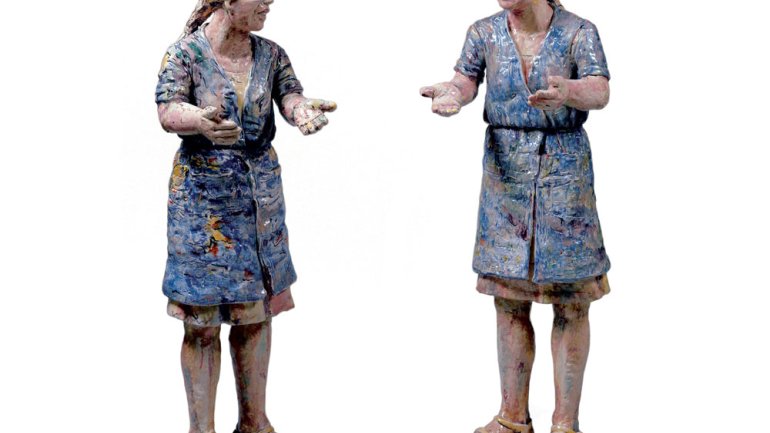Bigger, Better, More: The Art of Viola Frey
Bigger, Better, More: The Art of Viola Frey
Racine Art Museum
Apr. 24 - Aug. 16, 2009
Racine, WI
"Bigger, Better, More," the first retrospective since 1981 of Viola Frey's work, isn't actually very big. An exercise in thoughtful distillation by co-curators Davira S. Taragin and Susan Jefferies, it manages to spotlight Frey's recurring themes, passionate exploration of color and increasingly bold use of scale with just 22 well-chosen pieces. Making the selections must have been wrenching. Frey was phenomenally productive: although her sculpture sold consistently, her 15,000-square-foot warehouse/studio was still crammed with work when she died in 2004.
Frey, of course, is best known for her brilliantly colored, monumental ceramic figures. Startlingly fresh when they emerged in the early 1980s, these figures have become icons of 20th-century ceramics, so familiar that it's easy to take them for granted. It's a revelation to step back and see them in a fuller context. At the Racine Art Museum, the most iconic works weren't even visible from the first gallery, which was dominated by a raucous row of smaller, densely composed sculptures dating from 1969 to 1980. It was thrilling to round the corner and sense the scale ramping up, as the life-size Mrs. National Geographic, 1977-78, and Double Self, 1978, gave way to the imposing Double Grandmothers with Black and White Dresses, 1982, and two enormous men in power suits. The exhibition is fortified by some of Frey's most evocative paintings and pastels and a handful of her luscious, inscrutable plates. Frey established her national reputation as a sculptor, but her paintings and works on paper are like windows into the sculptures' world, revealing their chaotic relationships and emotional lives. Her plates and earlier sculptures carry much of the same thematic freight, creating a dynamic call and response around the gallery.
What impressed me most, however-I'm embarrassed I hadn't fully grasped it before-was Frey's extraordinary range. With her strong work ethic, well-honed technique and deep grounding in art history, archaeology, color theory, social politics and pop culture, she must have been an unstoppable force in the studio. She was a brash, confident draftsman, with the chops for everything from delicate impressionistic dabs to moody, slashing silhouettes, funky brushwork and a hopped-up wiggly line that riffs on 18th-century painted porcelain. Her glaze surfaces run the gamut from dusty matte to bright drippy gloss and the dry sheen of Egyptian paste. As her figurative pieces grew larger, their surfaces shifted from painterly naturalism in muted tones to a deeply textured, stark white glaze brushed with sharp blue, acid yellow, and angry oranges and reds. Frey's vocabulary of form was equally broad, embracing a range of exuberant, multifarious works often described as bricolage-sculptures and plates that combine a dizzying array of imagery, and large groups of assembled figures-alongside the elemental giant statues.
Frey's work is full of seeming contradictions. The giant figures with their enigmatic expressions are obvious to the point of being (her word) dumb, while the paintings and bricolage pieces are witty and open-ended. Her subject matter is avowedly autobiographical, and yet many of the images take on mythic stature: Mr. and Mrs. Everyman imbued with the aura of Greek kouroi. She piled realistically molded dolls and figurines into illogical, confusing abstractions, tossing them like word salad. Although Frey viewed her work as a totality, its connective tissues are not immediately apparent. Perhaps most fundamental is her obsession with figurines, which spilled out of the corners of her Oakland home and studio. She loved their emotional resonance, and favorites occur again and again: a rooster, a jointed male doll, a skeleton and a baseball player, among others. In Frey's paintings the figurines and sculptures in her studio come to life, jostling one another in a tumult of chaotic energy. The figurines reflect Frey's democratic impulse, in which sentimental knickknacks hold their own alongside large-scale, "serious" sculpture. I don't sense a jot of irony in Frey's approach to these goofy figurines; I think she respected their dignity. The figurines in Family Portrait, 1995, for example, read as emblems of emotion as well as personages in their own right. In Frey's world, they are simply part of the family.
The video playing in the gallery, while insightful and well put together, left an unfortunate impression of Frey as a misunderstood, even tragic figure. Having watched this, I found myself dredging up psychodrama in the repeated images of men looming in doorways and the huge, melancholy nude Weeping Woman, 1990-91-an impulse I resented. Frey's work evokes a wide spectrum of emotion, from fury to profound love. Her complex achievement transcends the particulars of mere personal history.
Jody Clowes is a curator and writer from Madison, WI.

